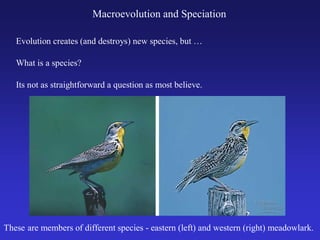
Speciation presentation in systemetic
- 1. What is a species? Its not as straightforward a question as most believe. Macroevolution and Speciation Evolution creates (and destroys) new species, but … These are members of different species - eastern (left) and western (right) meadowlark.
- 2. What is a Species? There is only one extant (existing) human species. What is a Species? There is only one extant (existing) human species.
- 3. i What is a Species? s a Species? And these are allof a single species. And these are all members of a single species.
- 4. Determining What Is and What Isn’t a Distinct Species Can Have Economic Consequences Northern spotted owl (left) and barred owl (right).
- 5. What is a Species? A species is a group of individuals capable of interbreeding to produce fertile offspring.
- 6. This is the biological species concept. Like all attempts to define a species, it has many problems.
- 7. One Problem in the Biological Species Concept For asexually-reproducing organisms, like these bacteria, what constitutes a species?
- 8. How Many Species Are There? We don’t know. About 2 million species have been described. Estimates of existing species number range from 4 million to 100 million (with 10-15 million being a more commonly considered upper estimate).
- 9. Two Patterns of Speciation
- 10. How Do Species Arise? Geographic isolation is the primary extrinsic reproductive isolating mechanism. The key to speciation is reproductive isolation of populations. There are extrinsic and intrinsic reproductive isolating mechanisms.
- 11. Reproductive Isolation May Occur With or Without Geographic Isolation Allopatric speciation occurs when geographic isolation creates a reproductive barrier (an extrinsic mechanism). Sympatric speciation occurs when a reproductive barrier is created by something other than geographic isolation (intrinsic mechanisms).
- 12. Allopatric Speciation Two species of ground squirrel are postulated to have descended from a common ancestral population that was separated by formation of the Grand Canyon. Harris’ antelope squirrel White-tailed antelope squirrel
- 13. Intrinsic Reproductive Isolating Mechanisms Are Always Required for Speciation Intrinsic mechanisms involve changes to organisms that prevent interbreeding. In allopatric speciation, intrinsic mechanisms come into play once populations are physically separated. In sympatric speciation, intrinsic mechanisms are the only ones involved. Harris’ antelope squirrel White-tailed antelope squirrel
- 14. Many Intrinsic Reproductive Isolating Mechanisms Drive Speciation (different habits within an overlapping range)
- 15. Courtship rituals, like these, are critical for mating within a species, but ineffective for attracting members of other species. Many Intrinsic Reproductive Isolating Mechanisms Drive Speciation
- 16. Courtship rituals, like these, are critical for mating within a species, but ineffective for attracting members of other species. Behavioral Isolation Mechanisms
- 17. Many Intrinsic Reproductive Isolating Mechanisms Drive Speciation
- 18. Many Intrinsic Reproductive Isolating Mechanisms Drive Speciation
- 19. Hybrid Infertility Was the Impetus for Cloning a Mule
- 20. Speciation Occurs at Widely Differing Rates A slow rate of speciation evidenced by a living horseshoe crab (13 extant species) and a 300 million year-old fossil species A rapid rate of speciation evidenced by Galapagos finches which have diversified into 13 species within the last 100,000 years.
- 21. Speciation Rates Generalists, like the horseshoe crab, tend to remain as stable species. Specialists, like the Galapagos finch, tend to be unstable as species. Speciation also becomes rapid when, as occurred with Galapagos finches, new niches become available.
- 22. Speciation Dynamics - Gradualism or Punctuated Equilibrium? Punctuated equilibrium appears to be a more accurate view of speciation dynamics.
- 23. Does Evolution Create the Perfect Organism? No, only better organisms as evolution is constrained by history and buffeted by random events. Essentially, every organism on earth is in significant part a sum of accidents.
- 24. Species Come and Go Best estimates from the fossil record indicate that greater than 99% of species that have exited are now extinct. A typical “lifetime” for a species is about 1 million years.
- 25. Mass Extinctions Are a Fact of Life
- 26. Gary Larson The Cretaceous/Tertiary Mass Extinction
- 27. Are We Now Causing a Mass Extinction?
- 28. Classifying Life’s Rich Diversity Why bother? An intrinsic reason is that modern classification systems tell who’s related to whom and how we all came to be.
- 29. Classifying Life’s Rich Diversity Why bother? A practical reason is that if we want to preserve an environment compatible with human life, we’d better know what’s out there.
- 31. How Do We Classify Organisms? Ideally, classification is based on establishing the evolutionary relationships between organisms. Cladistics is the method of classification based on establishing phylogenies (i.e. getting at evolutionary relationships. The evolutionary relationship between organisms is their phylogeny. Cladistics proceeds by comparing shared ancestral and shared derived characters between sets of organisms.
- 32. Cladistics A phylogeny (cladogram) for vertebrates. The greater the number of derived characters shared by a pair of organisms, the closer their degree of relationship. The closer the degree of relationship, the closer the most recent common ancestor. each node indicates a common ancestor
- 33. It’s Critical (and often difficult) To Distinguish Homology from Analogy Homologous structures, like the bat wing and gorilla arm, are similar because they are derived by modification of a shared ancestral structure. Homology is the key to establishing phylogenies.
- 34. Distinguishing Homology from Analogy Analogy is similarity due to convergent evolution. Analogy mistaken for homology confuses phylogenies.
- 35. Ocotillo of the US southwest Allauidia of Madagascar Another Set of Analogies Created by Convergent Evolution
- 36. Results of Cladistic Analyses Sometimes Run Counter to Classical Classification Schemes Which pair is more closely related? A lizard/crocodile or bird/crocodile? Cladistic analysis indicates that the bird/crocodile pair is more closely related.